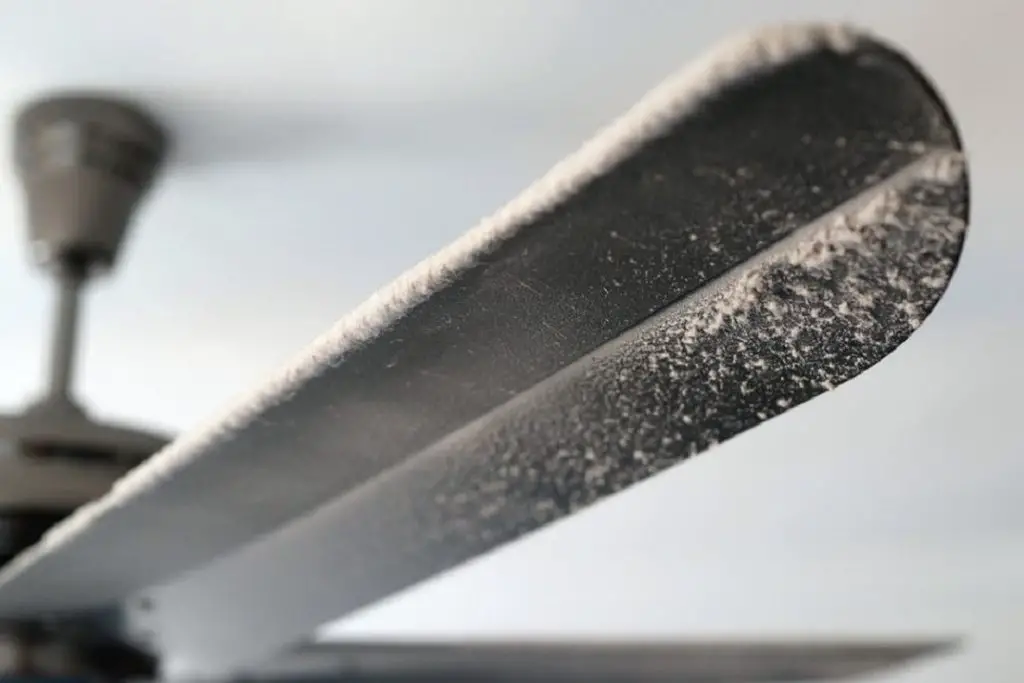How Often Should You Dust Your Ceiling Fans: Breathe Safer
Dust blowing around in the air isn’t healthy for you, and ceiling fans can both collect and spread the problem quickly. If you haven’t looked up in a while, turn your fans off and grab a step stool. Because we don’t always think about what’s going on over our heads, it can be easy to miss this detail. Moreover, those spinning blades aren’t easy to see clearly. Nevertheless, there’s no excuse for staying dirty once you’ve realized there’s a problem. I’ll explain how often you need to clean fans. Plus, I can show you great ways to avoid that nasty spill of dust that ends up on you and the floor. You’ll never have to live with dusty, crud flinging fans again.
How often should you dust your ceiling fans? You should dust your ceiling fans weekly. Dust buildup in your home can lead to allergy issues and an excess of dust mites. Especially if you live in a multi-person household or have pets, dust will accumulate quickly. Hence, you may need to dust more often if it’s obvious there’s a layer of buildup.
Why Do Ceiling Fans Get So Dusty
How often do you clean your ceiling fans? Walking into a home with ceiling fans that have an inch thick layer of fluffy brown dust, it’s hard not to wonder when they last cleaned, if ever. Even good housekeepers forget to check up all too often.
The ridges above doors, cabinet tops, high shelves, and yes, ceiling fans are easy to miss. So why do ceiling fans seem to get so much dust, and can you do anything to prevent it? Luckily, the answer is simple.
I recommend keeping a Black+Decker Cordless Lithium Dustbuster on standby. This small but powerful handheld vacuum will make quick work of those dusty fan blades. Furthermore, you’ll appreciate not getting the mess on you and the floor as a traditional duster would. Check the Amazon reviews right here.
A Technical Explanation of Fan-Dust
A ceiling fan in motion is pushing air. As it moves around in a circle, it’s also pressing against the air. That builds friction. Friction causes a low-level static charge to build up along the blades of your ceiling fan.
If you’ve seen the ingenious dusters that use static cling to get every particle of dust, then you already know what’s happening. You may not have thought of it that way before, but it’s the same concept. Static attracts the lightweight dust particles in the air. Additionally, it will attract pet hair, smoke, and other undesirables.
In some ways, your fan acts as a filter. Regrettably, the centrifugal force of the blades and air they move also disburses dust.
A Fan Problem You Never Considered
Most people think of dust as annoying and not much more. It doesn’t have any weight that you’d notice. However, your ceiling fan feels differently because that layer of dust can affect how it works.
Over time, dusty fan blades wear on the motor more than they should. Not only does that dirty gunk layer make the edge less aerodynamic, but it also has weight. Just because it’s not much, doesn’t mean it has no effect.
Dirty fan owners will likely have to change their fan motors more often. Additionally, you’re wasting electricity a small amount at a time, because your engine has to work harder. It’s not a big deal at any given moment, but when you live somewhere for years, it unquestionably adds up. Keeping a clean fan and home will save you money in the long run and keep you healthier.
Dusty Ceiling Fans are Bad for Your Health
When you wonder how often to clean your ceiling fan, do you ever think about allergies? If you’re like most people, the answer is probably ‘no.’ However, allergy sufferers should always look at their fans because that’s what moves the allergens around the house.
If your pollen or dander allergies seem a lot worse than usual, cleaning at home is the place to start. However, roughly twenty million Americans are allergic to dust mites, and you could be among them without ever knowing it.
Dust Mites
Do you or your children have asthma? Dust mites could be a big part of the problem. Naturally, even if you’re not an asthma or allergy sufferer, you should be concerned about those dusty fans. Having microscopic arthropods (members of the same family as spiders and crabs) breeding around the house by eating your dead skin cells is gross.
More disgusting still is what they do to cause allergies. Most people with dust issues aren’t allergic to the dead skin cells, or the dust mites themselves. It’s their feces that’s the real culprit. It should bug you to breathe in microscopic insect poo, even if it doesn’t make you sick.
Getting rid of dust mites isn’t as difficult as you might think with Hygea Natural Non-Toxic Insecticide Spray. In addition to killing off bed bugs and lice, this kid and pet safe spray will help get rid of those nasty dust dwellers. Grab yours from Amazon when you click here.
Allergens
Most dust is made up of human skin cells. However, that’s certainly not all there is in your dust bunny collection. In addition to human skin and dust mites, animal hair and dander, pollen, and other pollutants are all part of that thin layer of powder that settles everywhere.
Although you cannot altogether avoid allergens, you can help severely reduce them. Cleaning off those fan blades weekly is one way to prevent inhaling all that junk. Your ceiling fans are going to help collect it anyhow, so take advantage of the concentration and remove it all at once.
How & When to Dust Ceiling Fans
Avoiding cleaning ceiling fan blades is no good. You’ve probably done it before. Getting a dust shower is no fun. Now that you know what’s really in those dust bunnies, it’s downright repulsive. The good news is that you don’t need to dust like a classic french maid to get rid of that layer above your head.
Before you jump up to dust, it helps to set a schedule. Although many people have time off on weekends, that’s also when the house is probably the busiest. From weekend guests to the family staying in, it’s not the best time for cleaning. Instead, wait until Monday or Tuesday. Since most people will be out of the house more, this is an ideal time to get rid of your weekly accumulation of ceiling fan dust.
People who prefer low-tech solutions or those who just don’t want to climb a ladder to dust their ceiling fan will love the Eversprout Duster 3-Pack with Extension-Pole from Amazon. The extra reach is excellent, but the curved fan duster is better. You’ll be able to dust both sides of the blades with less mess, even if you have incredibly high ceilings. To have yours delivered, click here.
Reduce Dust in Your Home
In addition to cleaning your ceiling fan blades at least weekly, there are other ways to help reduce dust and allergens around the house. For example, you should not leave the windows open during high pollen count days. Merely checking the weather is enough to save you a lot of trouble.
Dust mites like damp conditions. Consider a dehumidifier if you live in a wet climate. You can also limit showers by not running them when you’re not inside. Moreover, closing windows and doors during the rainy or humid season will help keep dust mites and mold spores to a minimum.
Make sure you vacuum twice weekly with a good vacuum cleaner that doesn’t spit out dust. Keep your surfaces clean and uncluttered, and dust everywhere regularly to limit hidden pockets around your home. Also, restrict pet dander with regular grooming or choose low-dander pets.
Take the time to clean carpets, drapes, and fabric-covered furnishings regularly. These surfaces can harbor a shocking amount of dust. Just moving around or sitting on things can cause dust to rise into the air and collect on fan blades.
Naturally, you can take allergy pills and keep an inhaler around for asthma. However, these are not going to prevent dust and allergens. Instead, they reduce the symptoms while the problem remains.
Finally, get an excellent HEPA filter air purifier like the Holmes Allergen Remover Mini-Tower from Amazon. The HEPA filter will capture dust and allergens down to 0.3 microns in size. Plus, you’ll appreciate the three-year limited warranty and excellent customer service. Find out more about Holmes by clicking here.
Final Thoughts
Getting the dust off of your ceiling fan blades often is more important than most people think. It’s vital not to skip it just because you believe no one will notice. From pollen, and animal dander to dust mites, and their poop, you don’t want that hanging over your head.
People with asthma and those who are prone to illness, especially need to think about cleaning their ceiling fan blades more often. While most dust is made of human skin cells, there’s a lot of other bad stuff in those floating motes. If you have a busy house, you’ll probably find that you need to dust a little more often.
Instead of collecting dust mites and allergens to spread around the room, make sure you clean your fan weekly. It only takes a few minutes, and your lungs will thank you.

